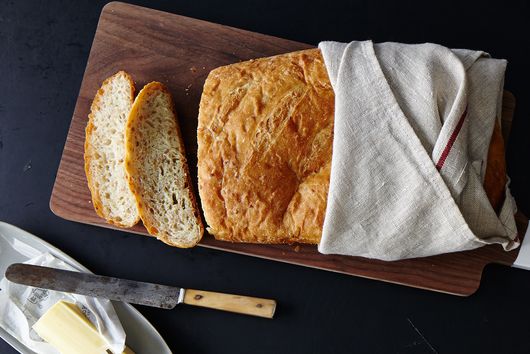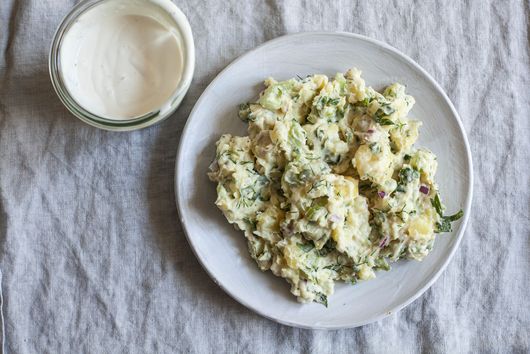Flax Seed Potato Bread
★★★★★
MAKES
1 large loaf
Ingredients
2 to 4
medium potatoes
2 1/2 teaspoons
active dry yeast
1 tablespoon
sugar
3/4 cup
slightly warm whole milk, or as needed
3 tablespoons
honey, lightly warmed
2 tablespoons
olive oil, plus some to grease and brush the bread
3 cups
bread flour, plus some for kneading
1 1/2 teaspoons
salt
1/3 cup
flax seeds, golden or brown
Instructions
- Cut the potatoes in half, without peeling them, and put them in a pot. Pour in enough cold water to cover them by about 1 inch, then bring the water to a boil and cook the potatoes until very tender, about 10 minutes. Turn off the heat, then let the potatoes sit in their cooking water until cooled. Reserving the water, remove the potato halves with a slotted spoon. Peel the halves with your fingers or with a small paring knife, and discard the peels. Transfer the potatoes to a large bowl if kneading by hand, or to the bowl of a stand mixer fitted with a dough hook. Mash the potatoes using a potato masher or a fork. You should have roughly 1 1/2 cups.
- Proof the yeast in 1/4 cup warm water (no hotter than 110º F) with the sugar for 5 to 10 minutes.
- Pour the cooled cooking liquid from the potatoes into a liquid measure, then add enough milk to measure 3/4 cup total. You should have a ratio of roughly 1/2 cup potato water to 1/4 cup milk. Pour the milk/potato water mixture into the bowl of mashed potatoes. Add the honey and the olive oil. Mix well to blend.
- If kneading by hand: Add the yeast mixture and 3 cups bread flour to the potato mixture. Using a sturdy wooden spoon, stir to bring the dough together. Add the salt and continue to work the dough until all the ingredients are well incorporated. Cover the bowl with a tea towel and let sit for 20 to 30 minutes. If using a stand mixer with a dough hook: Add the yeast mixture into the bowl. Add 2 cups bread flour and run the mixer for 1 to 2 minutes with dough hook, scraping down the sides as you go. Add the salt and and 1 cup additional bread flour. Run the dough hook to incorporate. Cover the bowl with a tea towel and let sit for 20 to 30 minutes.
- Once the dough has finished resting, begin to knead it. If using a stand mixer, add the flax seeds all at once. If kneading by hand, flour your work surface generously, then add only as much flour as necessary to keep the dough from sticking to your hands. Add the flax seeds a few tablespoons at a time while you knead. Knead the bread for about 10 minutes, until stretchy and supple.
- After 10 to 12 minutes, determine whether your dough is smooth and elastic using a windowpane test. If it's not, keep kneading for 5 more minutes, or as needed.
- Wash and dry your bowl. Put about 1 teaspoon olive oil in the bottom, and place the dough in. Turn to coat.
- Cover the bowl with a damp tea towel and set in a relatively warm, draft-free place to rise for 1 hour 30 minutes. *See note about rising below.
- Punch the dough down gently, knead it a few times, and shape it into a loaf. Preheat the oven to 325º F for a convection oven, or 350º F for a regular oven. If using a pizza stone, put the stone on a shelf in the bottom third of the oven at the same time that you turn the heat on.
- This recipe works well either as a free-standing oval on a pizza stone, in a clay pot, or in a loaf pan. If using a clay pot: Fill the lower half up about 3/4-full with water, then turn the lid over and fill it with water as well. Place both the water-filled lid and base in the oven while the dough rises. Shape the dough and let it rise in a parchment-lined loaf pan approximately the same size as the clay baking pan. Once the clay pot is warm, remove it from the oven and empty it, but leave the water-filled lid in the oven while baking. Make a sling with the parchment paper to transfer the dough into the clay pot, with the parchment paper still attached. If using a conventional loaf pan: Lightly oil the pan with olive oil, gently shape the dough into an oval, and place it inside of the pan with the parchment paper. If using a pizza stone: Shape the dough into an oval on the parchment paper. Slide a baking sheet under the parchment.
- Regardless of the baking method, use the sides of your hands to stretch the dough down from the top to create surface tension over the top of the loaf. Cover with a tea towel and allow the dough to rise again for 30 to 40 minutes.
- Using a bread knife or bakers' lame, cut one deep, long slit lengthwise or several shallow diagonal slits across the loaf. Brush the top of the loaf generously with olive oil. This gives the bread a beautiful, fragrant crust.
- Place the loaf in the oven to bake for 50 minutes, or until the bottom sounds hollow when tapped. Checking it after about 25 minutes: Convection ovens can often make the crust a bit dark, especially loaves made with milk, so if the crust is looking too brown after 25 or 30 minutes, cover it very lightly with a piece of foil.
- When it's done, remove the bread from the parchment and it let cool on a rack for at least 1 hour, preferably 3 or 4 hours.
- *A note about rising: Your bread dough won’t rise easily if it’s cold or subjected to drafts. My favorite place for protecting it from both is in my microwave. To create an ideal rising environment in your microwave: Put a small cup of water in your microwave, and turn it on high for 2 minutes. Remove the cup and put your covered bowl of dough in there and shut the door. This is only practical if you don’t expect there to be much activity with the microwave for the hour or so that the bread will rise. Or, you can warm up your regular oven to no more than 120º F (turning it off as soon as it is finished preheating so it doesn’t get any hotter), leave the door open just a crack for a minute or so, then pop your bread bowl in there, covered lightly with a tea towel, with the door closed.




